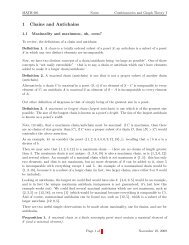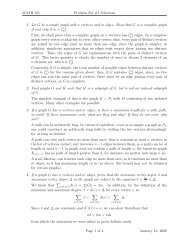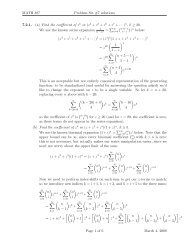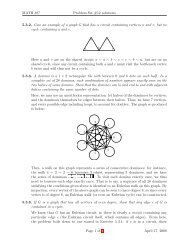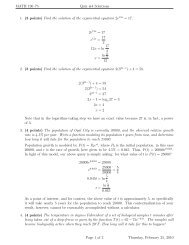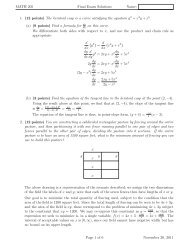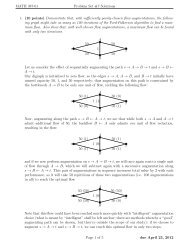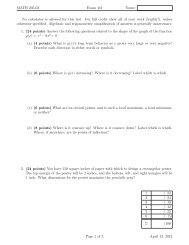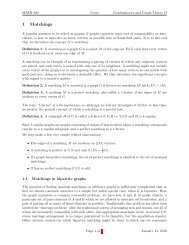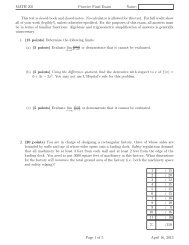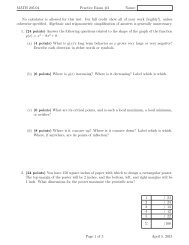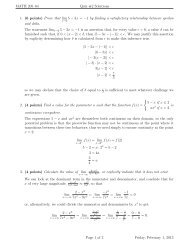MATH 387 Practice Final Exam Solutions 1. (12 points) For the ...
MATH 387 Practice Final Exam Solutions 1. (12 points) For the ...
MATH 387 Practice Final Exam Solutions 1. (12 points) For the ...
Create successful ePaper yourself
Turn your PDF publications into a flip-book with our unique Google optimized e-Paper software.
<strong>MATH</strong> <strong>387</strong><strong>Practice</strong> <strong>Final</strong> <strong>Exam</strong> <strong>Solutions</strong>Input: sequences a 0 ,a 1 ,a 2 ,a 3 ,...,a n and b 0 ,b 1 ,b 2 ,b 3 ,...,b nOutput: sequences c 0 ,c 1 ,c 2 ,c 3 ,...,c 2nset c 0 ,c 1 ,c 2 ,...,c 2n to 0;set i to 0;while i ≤ n doset j to 0;while j ≤ n doset c i+j to c i+j +a i b j ;set j to j +1;set i to i+1;return determined values c 0 ,c 1 ,c 2 ,...,c 2nThis works in much <strong>the</strong> same way as we multiply polynomials by hand. We start with<strong>the</strong> constant term of our multiplicand (setting i = 0, so we consider <strong>the</strong> term a 0 ), andmultiply one-by-one by every term of <strong>the</strong> multiplier, recording <strong>the</strong> results to be added to<strong>the</strong> appropriate terms of our result (here we add <strong>the</strong>m to <strong>the</strong> result progressively, whilea traditional hand-multiplication would wait until all were determined to add up rows).Then, we repeat this process with <strong>the</strong> linear term of our multiplicand (setting i = 0, andthus looknig at <strong>the</strong> term a 1 x), and continuing in such fashion until we have multipliedeach individual term of <strong>the</strong> multiplicand by <strong>the</strong> multiplier.(b) (3 <strong>points</strong>) Justify and state a good asymptotic bound in big-O notation on <strong>the</strong> number ofsteps taken by your algorithm.The innermost set of instructions (adding a product to c i+j ) takes constant time, or O(1)time. However, this instruction is repeated when j is 0, j is 1, when j is 2, when j is 3,and so forth up to when j is n, so <strong>the</strong> time timen by performing this set of instructionsn + 1 times is (n + 1) · O(1), or <strong>the</strong> linear time O(n). <strong>Final</strong>ly, since this loop is itselfrepeated over values of i ranging from 0 to n, <strong>the</strong> algorithm as a whole takes a number ofsteps given by (n + 1) · O(n); that is to say, performing a linear procedure n + 1 times,which takes O(n 2 ) steps, also known as quadratic time.3. (<strong>12</strong> <strong>points</strong>) Let G be a graph with n vertices and maximum degree ∆.(a) (6 <strong>points</strong>) Prove that <strong>the</strong> vertices of G can be colored with (∆+1) colors without using<strong>the</strong> same color on two adjacent vertices.Capsule version: consider coloring <strong>the</strong> vertices one by one, in an arbitrary order. At eachstage, we are coloring a vertex with ≤ ∆ neighbors, so <strong>the</strong>re are ≤ ∆ colors adjacent tothat vertex. Thus, <strong>the</strong>re are ≤ ∆ colors which are used on vertices adjacent to our currentvertex, which we are forbidden to use at that vertex; since <strong>the</strong>re are ∆+1 colors in total,<strong>the</strong>re must thus be at least one color which is not forbidden to use to color <strong>the</strong> vertexunder consideration. Let us use such a color on <strong>the</strong> current vertex, and continue in such afashion until all vertices are colored. Since we have shown that at each stage of <strong>the</strong> processwe are capable of coloring <strong>the</strong> current vertex, this process must necessarily be successfulin coloring all <strong>the</strong> vertices of G with ∆+1 colors.(An inductive proof is also possible, for greater formalism)n(b) (6 <strong>points</strong>) Prove that <strong>the</strong>re is a set of at least vertices in G such that no two of <strong>the</strong>m∆+1are adjacent.Consider a coloring of <strong>the</strong> variety shown to be possible in part (a). This may be consideredto be a partition of <strong>the</strong> vertices into “color classes”, consisting of all vertices of color 1,Page 2 of 6 April 20, 20<strong>12</strong>




